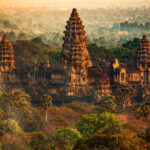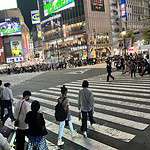Seoul, the bustling capital of South Korea, is a captivating city that seamlessly blends ancient traditions with modern innovation. With its vibrant culture, delicious cuisine, and stunning landmarks, Seoul offers an unforgettable experience for travelers of all ages. In this blog post, we’ll delve deeper into the top things to do, how to get around, local cultural nuances, and the best culinary delights to savor in this dynamic metropolis.
Contents
Discovering Seoul’s Cultural Gems
Gyeongbokgung Palace: Immerse yourself in the grandeur of the Joseon Dynasty by exploring Gyeongbokgung Palace, the largest and most impressive of the Five Grand Palaces. Witness the changing of the guard ceremony, a colorful spectacle showcasing traditional Korean military traditions.
Bukchon Hanok Village: Step back in time in Bukchon Hanok Village, a charming neighborhood filled with traditional Korean houses (hanoks). Wander through the narrow alleys and admire the unique architecture of these historic homes. Enjoy a leisurely stroll and soak up the peaceful atmosphere.
Insadong: This vibrant neighborhood is a treasure trove of traditional Korean crafts, antiques, and tea houses. Browse through the bustling markets and find unique souvenirs like handmade ceramics, calligraphy, and traditional Korean paper. Enjoy a cup of tea in a cozy tea house and experience the slow pace of life.
Namsan Mountain: For breathtaking views of Seoul, hike up Namsan Mountain. At the summit, you’ll find the N Seoul Tower, a popular spot for love locks and panoramic vistas. Take a cable car ride to the top for a more convenient option.
Myeongdong Street: This bustling shopping district is a paradise for shopaholics, with countless stores selling everything from high-end fashion to local street food. Explore the underground shopping malls for affordable finds, or visit the flagship stores of major brands.
National Museum of Korea: Discover Korea’s rich history and culture at the National Museum of Korea, one of the largest and most comprehensive museums in Asia. Explore the various galleries showcasing artifacts from ancient times to the present day. Don’t miss the stunning bronze statues and Buddhist sculptures.
Hongdae: This trendy neighborhood is known for its street art, independent cafes, and lively nightlife. Enjoy live music at one of the many bars and clubs. Explore the unique boutiques and shops selling everything from vintage clothing to handmade crafts.
Demilitarized Zone (DMZ): For a thought-provoking experience, take a tour to the Demilitarized Zone, the heavily fortified border between North and South Korea. Learn about the history of the Korean War and see firsthand the impact of the division.
Jjimjilbang: Experience a traditional Korean spa experience at a jjimjilbang, where you can enjoy saunas, hot baths, and relaxation rooms. Choose from various saunas with different temperatures and healing properties. Relax in the common areas and enjoy traditional Korean snacks and drinks.
K-pop Culture: Seoul is the heart of the K-pop industry, so if you’re a fan, try to catch a concert or visit a K-pop store. Explore the vibrant Gangnam district, known for its K-pop entertainment agencies and trendy shops.
Getting Around Seoul
Seoul has an excellent public transportation system, making it easy to get around. The subway is the most convenient way to travel, with a comprehensive network covering most of the city. Buses are another option, especially for reaching areas not served by the subway. For a more personalized experience, taxis are readily available, but they can be more expensive.
Local Cultural Nuances
Etiquette and Respect
- Bowing: Bowing is a common greeting in Korea. The deeper the bow, the more respect you are showing. It’s customary to bow when meeting someone for the first time or expressing gratitude.
- Shoe Removal: Always remove your shoes when entering a home, a traditional Korean restaurant, or a jjimjilbang (Korean spa). This is considered a sign of respect.
- Gift-giving: It’s customary to give gifts when visiting someone’s home or attending a special occasion. However, avoid giving gifts that are too expensive or elaborate. Popular gifts include traditional Korean items, such as ginseng or tea.
Food Culture
- Sharing: Koreans often share food at the table. It’s considered polite to offer your food to others and to accept food when offered.
- Chopsticks: Chopsticks are the primary utensils used for eating in Korea. However, it’s also acceptable to use a spoon for soup and rice.
- Drinking Culture: Drinking is a significant part of Korean culture, especially in social situations. It’s common to toast with others and to drink together.
Social Customs
- Hierarchy: Koreans place great importance on hierarchy and respect for elders. Always address older people with appropriate honorifics.
- Saving Face: Koreans are very concerned with saving face, which means avoiding embarrassment or loss of dignity. It’s important to be mindful of others’ feelings and avoid making them feel uncomfortable.
- Directness: While Koreans may seem polite and indirect on the surface, they can be more direct than Westerners in certain situations. It’s important to be clear and honest in your communication.
Body Language
- Eye Contact: Maintaining eye contact is considered polite in Korea. However, excessive eye contact can be seen as rude or aggressive.
- Hand Gestures: Be mindful of your hand gestures, as some gestures may be considered rude or offensive in Korean culture.
Language
- Korean Language: While English is widely spoken in major tourist areas, learning a few basic Korean phrases can go a long way in showing respect and appreciation for the local culture.
By understanding and respecting these local cultural nuances, you can enhance your experience in Seoul and build meaningful connections with the locals.
Exploring Seoul’s Culinary Delights
Seoul is a foodie’s paradise, offering a diverse range of flavors and culinary experiences. Here are some of the must-try dishes and culinary traditions:
Korean Barbecue (Go깃불)
- One of the most popular dining experiences in Seoul, Korean barbecue involves grilling meat at your table.
- Popular meats include beef, pork, and chicken, often marinated in soy sauce, sesame oil, and garlic.
- Enjoy the meat wrapped in lettuce leaves with ssamjang (a spicy dipping sauce), kimchi, and other side dishes.
Bibimbap
- A colorful rice dish topped with various vegetables, meat, and a spicy gochujang sauce.
- The ingredients are mixed together before eating, creating a harmonious blend of flavors and textures.
- Bibimbap can be vegetarian or meat-based, depending on your preference.
Kimchi
- A fermented cabbage dish that is a staple of Korean cuisine.
- Kimchi comes in many varieties, with different flavors and levels of spiciness.
- It is often served as a side dish or used as an ingredient in other dishes.
Tteokbokki
- A spicy rice cake dish that is often served with fish cakes and boiled eggs.
- The rice cakes are chewy and the sauce is typically made with gochujang and soy sauce.
- Tteokbokki is a popular street food and can be found at many stalls and restaurants.
Jajangmyeon
- Chinese-inspired black bean noodles with vegetables and meat.
- The sauce is made with black bean paste and is typically sweet and savory.
- Jajangmyeon is often served with a side of pickled radish.
Street Food
- Seoul is known for its vibrant street food scene, offering a variety of delicious and affordable snacks.
- Popular street food items include gimbap (rice rolls), gyeran-ppang (egg bread), and hotteok (sweet pancakes).
Tea Culture
- Drinking tea is a significant part of Korean culture.
- Popular teas include green tea, ginseng tea, and omija tea (five-flavor berry tea).
- Enjoy a cup of tea at a traditional tea house and experience the peaceful atmosphere.
Regional Specialties
- Different regions of Korea have their own unique culinary specialties.
- For example, seafood is popular in coastal areas, while spicy dishes are common in the southern regions.
Food Festivals
- Seoul hosts various food festivals throughout the year, showcasing the diverse culinary traditions of Korea.
- These festivals offer opportunities to sample a wide variety of dishes and learn about Korean food culture.
By exploring Seoul’s culinary delights, you can gain a deeper appreciation for Korean culture and create unforgettable memories.
Conclusion
Seoul is a vibrant and exciting city that offers something for everyone. From its ancient palaces to its modern skyscrapers, there’s always something new to discover. By following the tips in this guide, you can make the most of your trip and create unforgettable memories.










